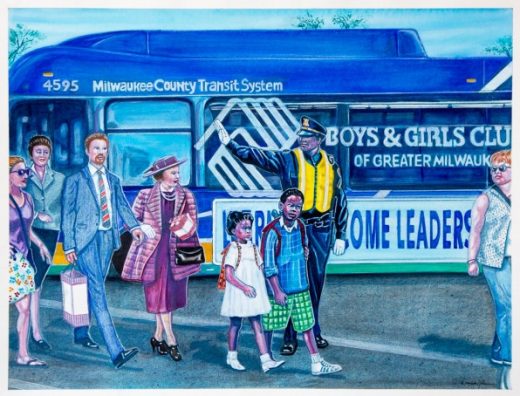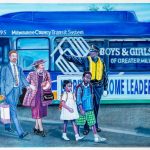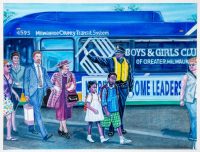How Public Art Can Serve As Philanthropy’s Calling Card
The abstract pigeon sculpture stands eight feet tall. The bird is majestic looking with red eyes, a blue-gray head, and a partially completed orange-and-brown plumage. But mid-wing that stops and a metal framework juts out–both an outline and a void where the rest of the body should be.
That’s because the bird isn’t just a pigeon but a passenger pigeon, a species that has literally disappeared because humans hunted it to extinction. The work, created by contemporary sculptor Tom Queoff, is intended to honor the Milwaukee Public Museum, an institution whose mission is to preserve and protect cultural and natural diversity (and has an actual taxidermy passenger pigeon among its own exhibits). It’s one of 25 pieces that include paintings, photography, and mixed-media art, each of which honors a separate nonprofit that’s been supported by the Northwestern Mutual Foundation, the philanthropic arm of the same-named financial firm.
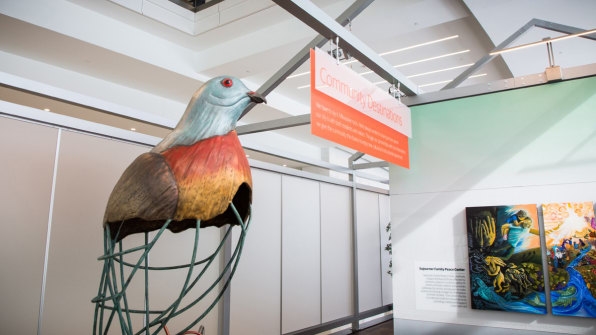
Together, the pieces are part of a free exhibit called the Giving Gallery, which is currently on at Northwestern Mutual’s headquarters in Milwaukee, Wisconsin. The works, which debuted in mid-February, will stay there for about a year, and then travel to cities including New York, Philadelphia, Tucson, and Phoenix next year. In this case, the goal is twofold: To highlight the work that’s being done by charitable groups, and provide the public with a new way to learn about it, and hopefully become inspired to donate, volunteer, or take action.
Over the past 25 years, the Northwestern Mutual Foundation has contributed more than $320 million toward two goals: It works nationally to help cure childhood cancer, and locally to support organizations that make Milwaukee a better community for kids to live.
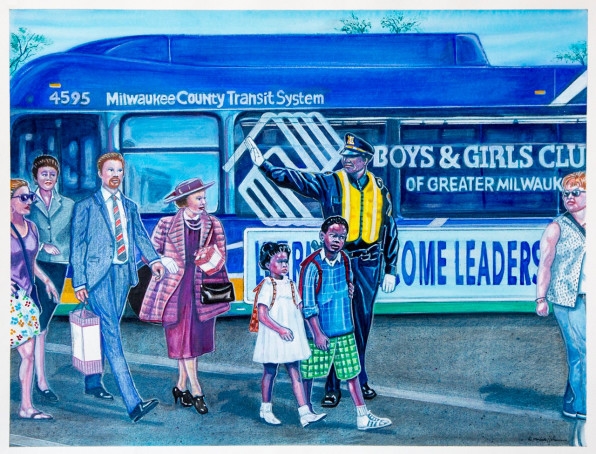
The Giving Gallery reflects the wide range of those efforts. For instance, to represent the Boys & Girls Clubs of Greater Milwaukee, artist Mutope Johnson painted a pair of children confidently crossing a busy city street while a metro bus emblazoned with the organization’s logo idles in the background. “They are completely surrounded by older adults while passing under the watchful protection of a police officer that is directing traffic and providing them safe passage,” Johnson writes in an artist’s statement. “We see the positive effects of being in a safe community environment that promotes education, leadership, and self-reliance at such a young age.”
For City Year Milwaukee, a student tutoring in the mentoring group associated with AmeriCorps, artist Della Wells created a collage featuring a red AmeriCorps jacket emblazoned with many badge-like smaller collages over overlapped drawing and cutout imagery, to represent scenes in the lives of different kids and volunteers. The work also includes cutouts of buzzwords (like “hype”) along with pictures of butterflies and other ephemera.
Whether this will pay off for the groups involved remains to be seen. Nonprofits generally don’t create their own elaborate art to rally more community support. Most have limited budgets, which necessitates putting time, money, and effort into programming first, in order to impact the communities they’re serving.
Still, more funders are thinking up creative ways to use the medium. In June 2017, philanthropist and renowned art collector Agnes Gund leveraged an existing prize work a different way–by selling it to enable the $100 million Art For Social Justice Fund that will be administered toward related cause work by the Ford Foundation. Bloomberg Philanthropies also runs the successful Public Art Challenge, which has awarded several cities $1 million each to implement large art projects that double as vehicles to civic revitalization, and are bringing both people and reinvestment to previously neglected areas.
(34)

